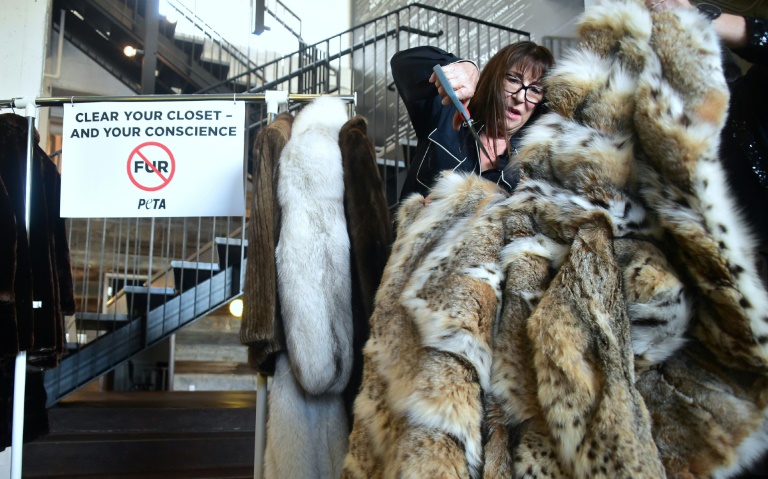With more and more fashion houses going fur-free, San Francisco banning fur sales in the city and British MPs considering outlawing all imports of pelts after Brexit, the signs do not seem good for the industry.
After decades of hard-hitting campaigning against fur, animal rights activists believe they scent victory.
Last week Donna Karan and DKNY became the latest in a flood of luxury brands to say they were planning to go fur free, following similar announcements by Gucci, Versace, Furla, Michael Kors, Armani and Hugo Boss in recent months.

Actress Anjelica Huston cuts up her Lynx fur coat in Los Angeles in January
US-based animal rights group PETA (People for the Ethical Treatment of Animals), which is famous for its spectacular anti-fur protests, declared that “2018 is the year that everyone is saying goodbye to fur.
“Times are changing and the end of fur farming is within reach!” it told its 687,000 Instagram followers.
Italian designer Donatella Versace: ‘I don’t want to kill animals to make fashion’
The British-based Humane Society International said the tide turned when Gucci declared it was going fur-free in October. Another hammer blow came this month when Donatella Versace said that “I don’t want to kill animals to make fashion. It doesn’t feel right.”
“Such influential brands turning their backs on cruel fur makes the few designers like Fendi and Burberry who are still peddling fur look increasingly out of touch and isolated,” said the society’s president Kitty Block.
Fendi’s Karl Lagerfeld shows little sign of second thoughts, however, and has said he will use real fur as long as “people eat meat and wear leather”.
– ‘Leather is next’ –
But PETA, which also campaigns for veganism, has warned the leather industry that is also in its sights, saying “You are next…”
And Professor Nathalie Ruelle, of the French Fashion Institute, told AFP that it was telling that the new fur-free brands “did not say anything about exotic leathers (such as crocodile, lizard and snakeskin).”
Of the big designers, Stella McCartney, a vegetarian and animal rights activist herself, has pushed the ethical envelope the furthest, refusing to use fur, leather or feathers.
But vegans want to go further still, with a ban on all animal products, which for some also means wool.
But the fur industry is not taking this lying down and has become much more vocal in its bid to counter animal rights groups’ social media campaigns.
The International Fur Federation (IFF) took Gucci to task when it went fur-free, asking if it “really wanted to choke the world with fake plastic fur…”
Philippe Beaulieu, of the French fur federation claimed fur-free was a marketing gimmick “trying to surf on emotion” to please millennials.
Fake fur, he said, was the real danger to the environment. “Brands who stop fur push synthetic fur which comes from plastic, a byproduct of the petrol industry, with all the pollution and harm to the planet that that entails.”
– China’s passion for fur –
In contrast, fur is natural and more and more durable and traceable, he said.
Arnaud Brunois, of the Faux Fur Institute, which he set up to counter the IFF, disputes this.
He insisted that “from an ecological point of view it was better to use a waste product from oil… than farm 150 million of animals then skin them and finally treat the pelts with chemicals.”
“It is part of the real fur industry’s marketing campaign to denigrate faux fur,” he added.
British designer Clare Waight Keller, Givenchy’s first female artistic director, put on a fake fur-heavy show in Paris
These days imitation can sometimes pass for the real thing as the British designer Clare Waight Keller proved in her fake fur-heavy Givenchy show at Paris fashion week earlier this month.
Luxury brand expert Serge Carreira at Sciences Po university in Paris said “fur was marginal for most of the fashion houses who have stopped using it.”
For instance, it only accounted for 10 million euros ($12.3 million) of Gucci’s six-billion turnover in 2017, or 0.16 percent.
While fur coats are now rarer on the streets of cities in the West, coats with fur collars — either fake or real, and sometimes a mixture of both, activists claim — are everywhere.
In China, however, the picture is very different.
Fur sales grew “phenomenally” there over the last decade, said IFF CEO Mark Oaten, and despite levelling off still dwarfs all those elsewhere combined.
The world’s biggest fur consumer is now also far by its it largest producer in a industry worth $30 billion globally in 2017.
Download our app